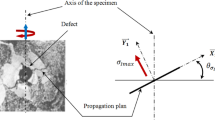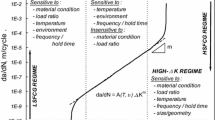Abstract
The need for more information on the “initiation period” in fatigue tests of weld specimens with penetration defects is discussed and the literature which relates the elasticity stress-concentration factor and Irwin's stress-intensity factor is reviewed.
A series of photoelasticity tests on two-dimensional plane-stress models of typical penetration defects is described. In particular a method for casting “ready to use” very narrow defects is explained.
The results are presented in a graph of stress-concentration factor against defect length. This graph has a “knee” at defect length-to-plate thickness ratios around 0.2. Below the “knee”, the stress-concentration factor changes very little with changes in defect length but, for lengths beyond the knee, i.e., ratios larger than 0.2, the stress concentrations increase linearly with defect length. It is concluded that such a critical defect length should have a strong effect on fatigue life of defective welds and that it may constitute a first approach to the specification of an “acceptable” level of penetration defects for production processes.
Similar content being viewed by others
References
Munse, W. H. andWilson, W. M., “Welded Structural Joints,” ASME Handbook—Metals Engineering Design, McGraw-Hill Book Company, New York (1965).
Sparagen, W. andRosenthal, D., “Fatigue Strength of Welded Joints—A Review of Literature,”Welding J.,21 (7),297s-348s (1942).
Harris, L. A., Nordmark, G. E. andNewmark, N. M., “Fatigue Strength of Butt Welds in Structural Steels,”Welding J.,34 (2),83s-96s (1955).
Newman, R. P. and Gurney, T. R., Brit. Welding Research Inst. Report, D2/3/58.
Welding Handbook, AWS, Sec. 1, 6th Ed. (1968).
Harrison, J. D., “The Analysis of Fatigue Test Results for Butt Welds with Lack of Penetration Defects Using a Fracture Mechanics Approach,”Fracture 1969: Proc. 2nd Int. Conf. on Fracture, Brighton, Chapman and Hall, London (1969).
Lawrence, F. V. andMunse, W. H., “Fatigue Crack Propagation in Butt Welds Containing Joint Penetration Defects,”Welding J.,52 (5),221s-225s (1973).
Newman, R. P. andDawes, M. G., “Exploratory Fatigue Tests on Transverse Butt Welds Containing Lack of Penetration,”Brit. Welding J.,12 (3),117–120 (1964).
Wells, A. A., “The Specification of Permissible Defect Sizes in Welded Metal Structures,”Fracture 1969: Proc. 2nd Int. Conf. on Fracture, Brighton, Chapman & Hall, London (1969).
Paris, P. C., “The Fracture Mechanics Approach to Fatigue,” Fatigue—An Interdisciplinary Approach, Proc. 10th Sagamore Army Materials Research Conf., Syracuse Univ. Press (1963).
Tetelman, A. S. andMcEvily, A. J., “Fracture of Structural Materials,”John Wiley & Sons, New York (1967).
Homma, H. andNakazawa, H., “Effect of Mean Stress on Fatigue Crack Initiation and Propagation,”Bull. of the Japan Soc. of Mech. Engrs.,16 (191),1–11 (1973).
McEvily, A. J. and Illg, W., “The Rate of Crack Propagation in Two Aluminum Alloys,” NACA Tech. Note 4394 (Sept. 1958).
Tada, H., Paris, P. andIrwin, G., The Stress Analysis of Cracks Handbook, Del Research Corp. Hellertown, PA (1973).
Rice, J. R., “Mathematical Analysis in the Mechanics of Fracture,”Fracture, An Advanced Treatise,II,Academic Press, Inc.,New York (1968).
Paris, P. C. andErodgan, F., “A Critical Analysis of Crack Propagation Laws,”J. Basic Engr., Trans. ASME,85 (4),528–534 (1963).
Hardrath, H. F. and McEvily, A. J., “Engineering Aspects of Fatigue Crack Propagation,” Crack Propagation Symp., Cranfield, England (1961).
Savin, G. N., “Stress Concentration Around Holes,”Pergamon Press, New York (1961).
Wahl, A. M. andBeeuwkes, R., “Stress Concentration Produced by Holes and Notches,”Product Engineering,5,92–94 (1934).
Sternberg, E. andSadowsky, M., “Three Dimensional Solution for the Stress Concentration Around a Circular Hole in a Plate of Arbitrary Thickness,”Trans. ASME,71,27–38 (1949).
Durelli, A. J. andSciammarella, C. A., “Elastoplastic Stress and Strain Distribution in a Finite Plate with a Circular Hole Subjected to Uni-dimensional Load,”Trans. ASME 85E (J. Appl. Mech.) 1,115–121 (1963).
Marloff, R. H., Leven, M. M., Ringler, T. N. andJohnson, R. L., “Photoelastic Determination of Stress-intensity Factors,”Experimental Mechanics,11 (12),529–539 (1971).
Author information
Authors and Affiliations
Rights and permissions
About this article
Cite this article
Burger, C.P., Zachary, L.W. & Riley, W.F. Application of photoelasticity to a weld-penetration problem. Experimental Mechanics 15, 73–80 (1975). https://doi.org/10.1007/BF02319740
Issue Date:
DOI: https://doi.org/10.1007/BF02319740




